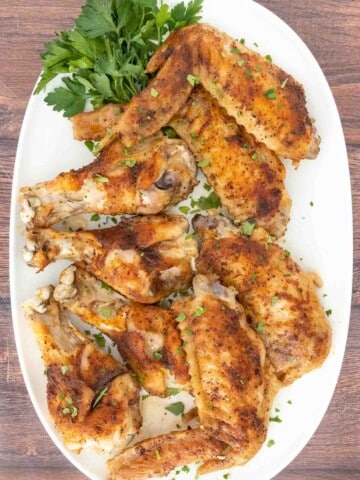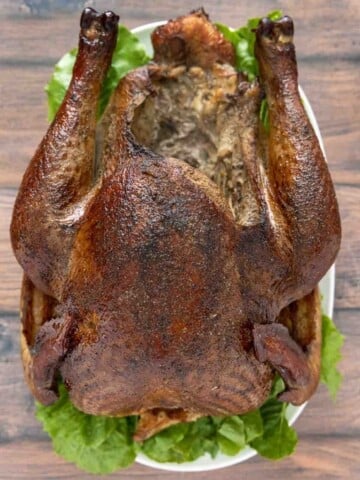A spatchcock turkey takes a fraction of the time to roast a conventional turkey. Spatchcocking a turkey allows all of the skin to get crispy while keeping the meat juicy.
The shorter time spent in the oven helps keep the bird from drying out. The shorter cooking time also gives you more time to enjoy Thanksgiving Day.

Audio Player
Making a spatchcock turkey is easier than you think. You can remove the backbone with a sharp knife or kitchen shears in just a few minutes.
The trick to spatchcocking a turkey is pushing down on the skin side of the turkey until you hear the bones crack. That will keep it flat as it roasts.

“Spatchcock” is a culinary term for removing the backbone and splaying a whole turkey or chicken so it is flat when it cooks. You’ll hear it referred to as a butterflied turkey.
If you love turkey, check out our dry brine turkey recipe and easy smoked turkey recipe.
Ingredients to make Roasted Spatchcock Turkey

Let’s start by gathering the ingredients we need to make our easy spatchcock turkey recipe. In Chef Speak, this is called the Mise en Place, which translates into Everything in its Place.
Not only does setting your ingredients up ahead of time speed the cooking process, but it also helps ensure you have everything you need to make the dish.
Can I brine the turkey before spatchcocking?
Absolutely. You can use a dry or wet brine to make the turkey extra moist with juicy meat. Our poultry seasoning is a good beginning for the dry brine; you would need to add kosher salt to the seasonings.
You can also use fresh herbs to make the seasoning mixture.
How to Spatchcock Turkey
Follow along with my simple step-by-step instructions to learn how to spatchcock turkey in your home kitchen.
- Remove the turkey half an hour before you’re ready to start cooking.
- Remove turkey giblets and neck from the cavity of the turkey. Save the giblets for stuffing or gravy.

- Add the marjoram, rosemary, sage, thyme, black pepper, nutmeg, and sweet paprika to a small bowl.
- Whisk to combine the dry brine.
This is our homemade poultry seasoning. Feel free to substitute your favorite store-bought poultry seasoning.

- Place the whole turkey breast side down on a large cutting board.
- Find the turkey’s backbone from the cavity side, then carefully slice down the side of the backbone (or use sharp kitchen shears to cut out the backbone).
- Then, repeat the step and cut the other side of the backbone. *Save the backbone to make turkey gravy or soup.
- Flip the bird back over so the breast side is up, and press down on it until the rib bones crack. This will ensure it’s flat.
- Pat the skin dry with paper towels. Removing the moisture from the skin will help create the crisp skin that everyone loves.
- Flip the bird over and dry the cavity with paper towels.
Preheat the oven to 350 degrees F.

- Season the cavity side of the bird with ⅓ of the poultry seasoning, rubbing it into the cavity.
- Turn the turkey back over.
- Sprinkle the skin side with the remainder of poultry seasoning, coating all of the exposed skin. Then, rub the seasoning into the skin.
- Place the seasoned bird on a sheet pan with a wire rack (or flat on a sheet pan or roasting pan). Let the turkey sit for 20 -30 minutes, allowing the dry rub to penetrate the meat and letting the bird come to room temperature.
*Using a grate will let the air circulate around the bird, helping it cook more evenly and crisp up. - Place the sheet pan on the center rack of the preheated oven and roast for one hour. After one hour, remove the turkey from the oven and brush the bird with melted butter. This will help give the skin a golden-brown crispy skin as the turkey roasts.
- Wrap the end of the drumsticks with aluminum foil. This will keep the skin from pulling back up the leg. Increase the oven temperature to 375 degrees F., place the pan back in the oven, and continue to roast for another 20 -30 minutes, or until a meat thermometer inserted into the thickest part of the thigh reaches an internal temperature of 165 degrees F.
*Cooking time will vary depending on the size of the turkey.
The higher temperatures for the second part of the roast will get the skin extra crispy and brown.
Let the turkey rest for 15-20 minutes before slicing to allow the juices time to redistribute into the meat. Use the pan for the gravy.
Chef Tip: Place a meat thermometer into the thickest part of the thigh and one in the thickest part of the breast to ensure that both the white meat and dark meat are fully cooked and not overcooked.

Cooking a spatchcock turkey makes a lot of sense if you’re making a smaller bird for this year’s Thanksgiving. Everyone will rave about the juicy, moist, delicious turkey, making you look like a superstar in the kitchen!
For a complete dinner, add our easy homemade turkey gravy, potato bread stuffing, mashed potatoes, mashed sweet potatoes, cranberry sauce, and homemade dinner rolls.
Leftover turkey should be stored refrigerated in an airtight container for 4-5 days. They can also be frozen in a freezer-safe container or zip-lock bag for up to two months.
Make my Jersey diner-style turkey croquettes and homestyle turkey noodle soup with the leftovers.
Recipe FAQ’s
Absolutely. A roasted spatchcocked turkey is juicier, crisper, and takes less time to cook than a conventional whole bird. And because the turkey is flattened, it cooks more evenly.
You can also smoke a spatchcocked turkey for a smoky flavor.
The only downside is the appearance. It just doesn’t look as homey and inviting as a conventionally roasted bird.
The general rule of thumb is 1 pound uncooked per person; for leftovers or good eaters, allow 1.5 pounds per person. The larger the turkey, the greater the meat-to-bone ratio. A bird that weighs 18 pounds and up will yield more meat.
More Recipes You’ll Love!

Spatchcock Turkey
Equipment
- sheet pan
Ingredients
- 12 -14 lb turkey
- 4 tablespoon unslated butter to brush the turkey after the first roast.
Poultry Seasoning
- 1 teaspoon dry marjoram
- 1 teaspoon dry rosemary
- 1 teaspoon dry thyme
- 1 teaspoon dry sage powder
- 1 teaspoon garlic powder
- ½ teaspoon black pepper
- ½ teaspoon nutmeg powder
- ½ teaspoon paprika powder
Instructions
- Remove the turkey a half hour before you're ready to start cooking.
- Remove turkey giblets and neck from the cavity of the turkey. Save them for the stuffing or gravy.
- Add the marjoram, rosemary, sage, thyme, black pepper, nutmeg, and sweet paprika to a small bowl. Whisk the seasonings to combine.
- Place the whole turkey breast side down on a cutting board.
- Find the backbone of the turkey from the cavity side, then carefully slice down the backbone on one side (or use sharp kitchen shears to cut out the backbone). Then, repeat the step and cut the other side of the backbone. *Save the backbone to make the turkey gravy or soup.
- Flip the turkey back over so the breast side is up, and press down on it until it cracks and flattens.
- Pat the turkey skin dry with a paper towel.
- Flip the turkey over and dry the cavity with a paper towel.
- Season the cavity side of the turkey with about ⅓ of the poultry seasoning, rubbing it into the cavity.
- Turn the turkey back over and sprinkle with the remainder of poultry seasoning on the skin, coating all of the exposed skin. Then rub the seasoning into the skin.
- Place the seasoned bird on a sheet pan with a wire rack (or flat on a sheet pan or roasting pan).*Setting the turkey on the grate will let the air circulate around the bird, helping it cook more evenly and crisp up.
- Preheat the oven to 350 degrees F.
- Let the turkey sit for 20 -30 minutes, allowing the dry rub to penetrate the meat and letting the bird come to room temperature.
- Place the sheet pan on the center rack of the preheated oven and roast for one hour.
- After one hour, remove the turkey from the oven and brush the bird with melted butter. This will help give the skin a golden-brown crispy skin.
- Wrap the end of the drumsticks with tinfoil this will to keep the skin from pulling back up the leg
- Increase the oven temperature to 375 degrees and place the pan back in the oven and continue to roast for another 20 -30 minutes, or until a meat thermometer inserted into the thickest part of the meat reaches an internal temperature of 165 degrees.
- Let the chicken rest for 15-20 minutes before serving to allow the juices time to redistribute into the meat.








Charlotte Valitzski says
Never tried this before so did dress rehearsal with a chicken. The skin was crispy, the spice blend was very good and since I had leftover spice blend I threw it in with the broth I made from the backbone, etc. that was a good move, tasty broth. Now, onto a turkey!
Chef Dennis Littley says
It’s a great way to cook a turkey or a chicken. Let me know how your turkey turns out.